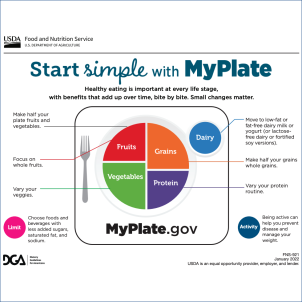
What’s on Your Plate?
The Food Pyramid that many of us learned about in school is now ancient history. That old guideline on food groups and servings has been replaced by MyPlate - Opens in a new window. The MyPlate concept was designed by the United States Department of Agriculture to promote healthy eating habits that will last a lifetime. We are all busy these days, but focusing on balanced meals for the whole family will help to make sure that everyone stays happy and healthy! Some important points about MyPlate:

- Focus on consuming a variety of foods, try to eat appropriate portion sizes, and aim for nutritionally dense foods. Aim to eat all the colors of the rainbow to obtain the nutrition that the body needs for energy and growth. It is fun for kids to participate in picking colorful foods when grocery shopping and helping in the kitchen. For portion sizes, remember that children do not need as big a portion as adults to meet their daily needs. See the picture below for some helpful tips to estimate various serving sizes. “Nutritionally dense” foods means are foods that provide a high amount of nutrition through vitamins and minerals while providing a small to moderate amount of calories. Also shown below is an example of the MyPlate model. For a more detailed view please view the full MyPlate poster - Opens in a new window.
- Choose foods and beverages that contain less saturated fat, sodium, and added sugars. Use the Nutrition Facts Label to compare packaged foods and beverages. Check out our blog about Staying Smart About Sodium.
- Start by making small changes that eventually build healthier eating habits. You don’t have to make a lot of dramatic changes at once! This often leads to new dietary habits not sticking. Make small changes to improve the health of your overall diet and in time, you and your family will be making better, healthier decisions without even thinking about it!
- Don’t give up. Trying new foods can be hard for some children. It can take 10-15 exposures or more of a new food for a child to decide to try it. Offer small pieces of a new food multiple times as part of a healthy plate. The more a child sees a new food, the more comfortable they will become to try the new food you offer.
- Support healthy eating for everyone! Be a role model. Make healthy choices for the whole family, not just the kids.
- Don’t forget to include physical activity daily. Aim for 60 minutes of moderate activity every day for your kids and 30 minutes 5 days out of the week for adults. Physical activity counts as anything that gets your heart rate increased and blood pumping. This could be taking a walk around the neighborhood with your kids, going for a bike ride, or playing a game of tag in the front yard.
- The MyPlate goal is for half of your family’s plate to be fruits and vegetables, and at least half of your grains to be whole grains.
Below is a recipe idea that incorporates all of the MyPlate ideals into it. The best way to get kids to try new foods is to have them be involved as much as possible in the food planning and cooking process.
Rainbow Chili
By Stephanie Hanne, MS, RD, CSSD, CNSC
Ingredients
1 zucchini, sliced
1 yellow squash, sliced
1 red bell pepper, diced
1 jalapeño pepper, minced (optional)
1 onion, diced
4 garlic cloves, minced
1 can crushed tomatoes with liquid
1 can tomato paste
1 can black beans
1 can chili beans
1 can whole kernel corn
1 tbsp olive oil
1 tbsp chili powder
1/2 tsp dried oregano
1/4 tsp cayenne pepper
1/2 tsp ground black pepper
Directions
- Heat oil in a large pot over medium high heat. Stir in zucchini, yellow squash, bell pepper, jalapeño, onions, and garlic. Sauté until tender (about 5 minutes).
- Add canned ingredients and reduce heat to simmer.
- Stir in spices and simmer for 45 to 60 minutes, stirring occasionally, until chili reaches desired consistency. Serve while warm!
Created with input from Brenda Manzanarez, MS, RDN, Anet Piridzhanyan, MS, RDN, Paula Mrowczynski-Hernandez, MEd, RDN, CDCES, CSSD, and Alaina Vidmar, MD.


